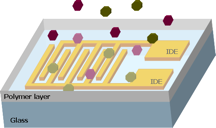Go to
Judith Staginus
PhD Student, Department of Chemical Engineering, Delft University of Technology, Delft, The Netherlands
Polymer-based Capacitive Sensor Array
The progress in development of electronic noses and electronic tongues makes it promising to utilize the technique of chemically diverse multi-array sensors combined with multi-component analysis tools and pattern recognition techniques for a wider range of medical and environmental applications. The Ph.D. project on polymer-based multi-array sensors aims to develop such a sensor for the detection of organic compounds in the aqueous phase. The sensor platform is formed by metallic interdigitated electrodes (IDEs), also known as finger electrodes, deposited onto an inert substrate such as glass via standard IC technologies. A polymer coating of controlled thickness serves as a partially selective sensing layer. Interaction of the sensing layer and the target compound is achieved via adsorption, absorption and consequent swelling of the polymeric layer. This interaction influences the electric field established between the finger electrodes and leads to a change of the capacitive response of the sensor that can be measured (Figure 1).

Figure 1. Schematic representation of a polymer-based IDE sensor.
The choice of chemical sensing layers must satisfy the requirements for fast diffusion processes, reversibility and sufficient chemical diversity. Chemical diversity within a sensor array can be achieved by using chemically diverse polymer layers on the different sensor elements. An electronic sensing interface connects the individual sensors to an electronic response array. As the partial selectivity and hence cross-sensitivity among the different sensor elements leads to a multi-variant response, a sophisticated algorithm is required that interprets this response in functions of pollutant presence and concentration.
About the speaker:
 Judith Staginus finished a 3-year apprenticeship as a car electrician at Daimler Sprinter Werk, Düsseldorf, Germany in 2001. She received the academic degree of Master in Industrial Chemical Engineering at the Group T Engineering College in Leuven, Belgium in 2007 and the Master in Environmental Science and Technology at the Catholic University of Leuven, Belgium in 2008. She is currently pursuing her Ph.D. in the field of environmental sensors. Her Ph.D. project is on polymer-based chemical capacitive sensors for the detection of organic water pollutants. To her research activities belong the development of the sensor platform and fluidic system, the synthesis of polymeric sensing layers and the sensor surface modification with functional monolayers. She is also involved in several teaching activities. Her research interests are sustainable engineering solutions.
Judith Staginus finished a 3-year apprenticeship as a car electrician at Daimler Sprinter Werk, Düsseldorf, Germany in 2001. She received the academic degree of Master in Industrial Chemical Engineering at the Group T Engineering College in Leuven, Belgium in 2007 and the Master in Environmental Science and Technology at the Catholic University of Leuven, Belgium in 2008. She is currently pursuing her Ph.D. in the field of environmental sensors. Her Ph.D. project is on polymer-based chemical capacitive sensors for the detection of organic water pollutants. To her research activities belong the development of the sensor platform and fluidic system, the synthesis of polymeric sensing layers and the sensor surface modification with functional monolayers. She is also involved in several teaching activities. Her research interests are sustainable engineering solutions.
Secondary navigation
- EPFL Workshop on Logic Synthesis and Emerging Technologies
- Luca Amaru
- Luca Benini
- Giovanni De Micheli
- Srini Devadas
- Antun Domic
- Rolf Drechsler
- Pierre-Emmanuel Gaillardon
- Jie-Hong Roland Jiang
- Akash Kumar
- Shahar Kvatinsky
- Yusuf Leblebici
- Shin-ichi Minato
- Alan Mishchenko
- Vijaykrishnan Narayanan
- Ian O'Connor
- Andre Inacio Reis
- Martin Roetteler
- Julien Ryckaert
- Mathias Soeken
- Christof Teuscher
- Zhiru Zhang
- Symposium on Emerging Trends in Computing
- Layout synthesis: A golden DA topic
- EPFL Workshop on Logic Synthesis & Verification
- Luca Amaru
- Luca Benini
- Robert Brayton
- Maciej Ciesielski
- Valentina Ciriani
- Jovanka Ciric-Vujkovic
- Jason Cong
- Jordi Cortadella
- Giovanni De Micheli
- Antun Domic
- Rolf Drechsler
- Henri Fraisse
- Paolo Ienne
- Viktor Kuncak
- Enrico Macii
- Igor Markov
- Steven M. Nowick
- Tsutomu Sasao
- Alena Simalatsar
- Leon Stok
- Dirk Stroobandt
- Tiziano Villa
- Symposium on Emerging Trends in Electronics
- Raul Camposano
- Anantha Chandrakasan
- Jo De Boeck
- Gerhard Fettweis
- Steve Furber
- Philippe Magarshack
- Takayasu Sakurai
- Alberto Sangiovanni-Vincentelli
- Ken Shepard
- VENUE
- Panel on Circuits in Emerging Nanotechnologies
- Panel on Emerging Methods of Computing
- Panel on The Role of Universities in the Emerging ICT World
- Panel on Design Challenges Ahead
- Panel on Alternative Use of Silicon
- Nano-Bio Technologies for Lab-on-Chip
- Functionality-Enhanced Devices Workshop
- More Moore: Designing Ultra-Complex System-on-Chips
- Design Technologies for a New Era
- Nanotechnology for Health
- Secure Systems Design
- Surface Treatments and Biochip Sensors
- Security/Privacy of IMDs
- Nanosystem Design and Variability
- Past Events Archive

